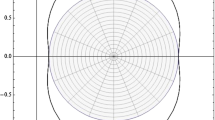Abstract
Let be the class of functions f(z) which are analytic in the open unit disk and satisfy . Also, let denotes the subclass of consisting of f(z) which are p-valently starlike of order α(0 ≦ α < p). A new subclass of is introduced by
for some real λ > 0. The object of the present paper is to consider some radius properties for such that .
2010 Mathematics Subject Classification: Primary 30C45.
Similar content being viewed by others
1 Introduction
Let be the class of functions f(z) of the form
which are analytic in the open unit disk and satisfy
For , we say that f(z) belongs to the class if it satisfies
for some real number λ > 0.
Let us consider a function f δ (z) given by
Then, we can write that
with
and
Thus, if δ = 2, then
This shows that for λ ≧ 1.
If δ = 3, then we have that
Which shows that for λ ≧ 5.
Further, if δ = 4, then
which shows that for λ ≧ 11.
If p = 1, then is defined by
for some real number λ > 0. Note that (1.5) is equivalent to
Therefore, this class was considered by Obradović and Ponnusamy [1]. Further-more, this class was extended as the class by Shimoda et al. [2].
Let denotes the subclass of consisting of f(z) which satisfy
for some real α (0 ≦ α < p).
A function is said to be p-valently starlike of order α in (cf. Robertson [3]).
2 Coefficient inequalities
For , we consider the sufficient condition for f(z) to be in the class .
Lemma 1 If satisfies
then .
Proof We note that
Therefore, if
then .
Example 1 If we consider a function given by
with
for n ≧ p + 2, then we see that
Thus, this function f(z) satisfies the inequality (2.1). Also, we see that
Therefore, we say that .
Next, we discuss the necessary condition for the class .
Lemma 2 If satisfies
with b n = |b n | ei(n-p)θ(n = p + 1, p + 2, p + 3,...), then
Proof Let us define the function F(z) by
It follows that
for . Letting z = |z| e-iθ, we have that
If we take |z| → 1-, we obtain that
which implies that
Remark 1 If we take p = 1 in Lemmas 1 and 2, then we have that
(i)
and
(ii)
3 Radius problems
Our main result for the radius problem is contained in
Theorem 1 Let (p - 1 ≦ α < p) with
and b n = | b n | ei(n-p)θ(n = p + 1, p + 2, p + 3, ...). If , then belongs to the class for , where |δ0(λ)| is the smallest positive root of the equation
that is,
Proof Since
we have that
In view of Lemma 1, we have to show that
Note that satisfies
Applying Cauchy-Schwarz inequality, we obtain that
Let |δ|2 = x. Then, we have that
This gives us that
Let us define the function h(|δ|) by
Then, h (|δ|) satisfies h (0) = -λ < 0 and . Indeed, we have that h (|δ0(λ) |) = 0 for
This completes the proof of the theorem.
Corollary 1 Let with
and b n = |b n | ei(n-1)θ(n = 2, 3, 4,...). If δ ∈ ℂ (|δ| < 1), then belongs to the class for , where |δ0(λ)| is the smallest positive root of the equation
that is,
Remark 2 In view of (3.2), we define the function g(λ) by
Then, we have that
for λ > 0. Therefore, |δ0(λ)| given by (3.2) is increasing for λ > 0.
Remark 3 If we put in Theorem 1, then
Therefore, if we consider , then we see that
and if we make λ = 5, then we have that
References
Obradović M, Ponnusamy S: Radius properties for subclasses of univalent functions. Analysis 2005, 25: 183–188. 10.1524/anly.2005.25.3.183
Shimoda Y, Hayami T, Owa S: Notes on radius properties of certain univalent functions. Acta Univ Apul 2009, 377–383. (Special Issue)
Robertson MS: On the theory of univalent functions. Ann Math 1936, 37: 374–408. 10.2307/1968451
Author information
Authors and Affiliations
Corresponding author
Additional information
4 Competing interests
The authors declare that they have no competing interests.
5 Authors' contributions
QF carried out the main part of this article. All authors read and approved the final manuscript.
Rights and permissions
Open Access This article is distributed under the terms of the Creative Commons Attribution 2.0 International License (https://creativecommons.org/licenses/by/2.0), which permits unrestricted use, distribution, and reproduction in any medium, provided the original work is properly cited.
About this article
Cite this article
Uyanik, N., Owa, S. Radius properties for analytic and p-valently starlike functions. J Inequal Appl 2011, 107 (2011). https://doi.org/10.1186/1029-242X-2011-107
Received:
Accepted:
Published:
DOI: https://doi.org/10.1186/1029-242X-2011-107




